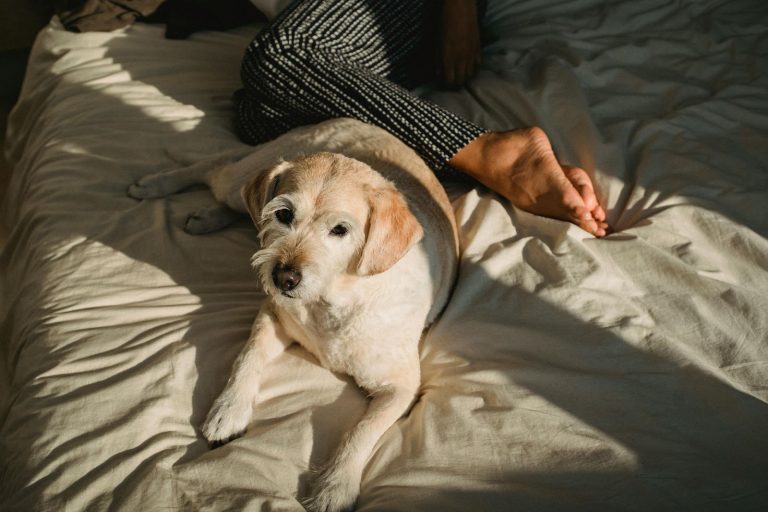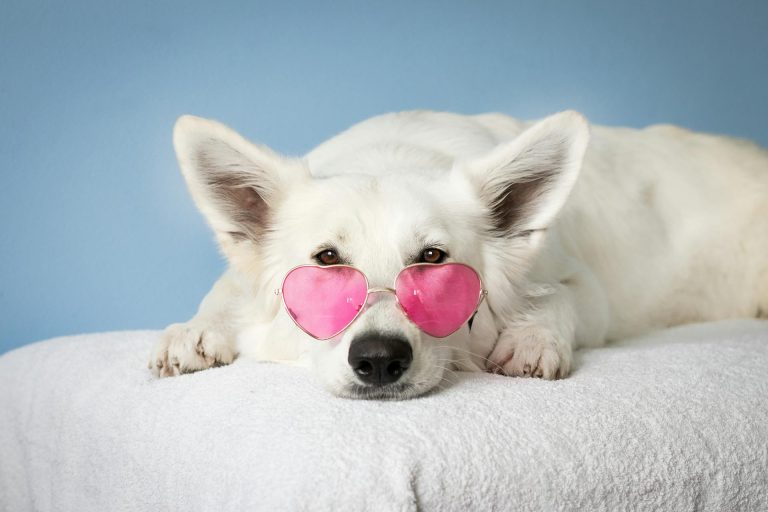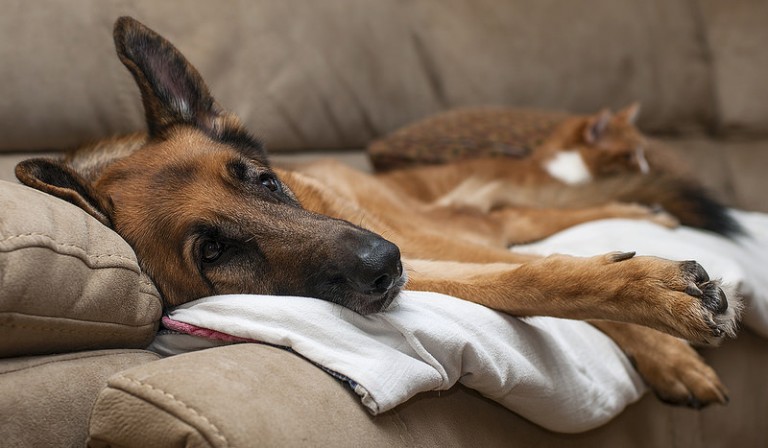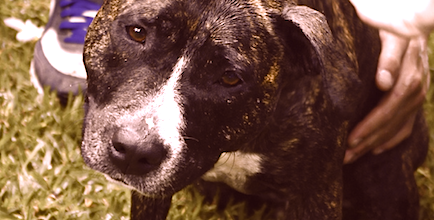All About 3-Legged Pets and Post-Amputation Care
Being a “tripod” dog or cat is not a curse. Read this fascinating article to find out how 3-legged pets adjust to life after amputation.

There’s an old saying that applies equally to dogs and cats:
“Dogs [and cats] have 3 legs and a spare.”
This neatly sums up how 3-legged pets cope with the loss of a limb: These tripods (or “tripawds”), as they are lovingly called, just get on with things.
Even agile cats or energetic dogs adapt to their new way of life — and in a surprisingly short period of time.
So if you are concerned about whether or not it’s fair to put your pet through leg amputation surgery — and perhaps you’re considering euthanasia as an alternative — then don’t let assumptions about your pet’s quality of life afterward influence that decision.
In this article on 3-legged pets and post-amputation care, we’ll discuss:
- Why losing a limb is sometimes the best option
- Post-amputation care for your pet immediately after surgery
- How to help your pet regain mobility
- Protecting their remaining limbs for the long term


Don’t leave your pet’s safety to chance
Sign up for Petful recall alerts today.

Fact: 3-Legged Pets Are Popular
This statement may sound a little odd, but it’s a fact.
My clinic works closely with the RSPCA. The inspectors often tell us how those pets with a “disability,” such as those missing a leg, get adopted the fastest.
There’s something about the sympathy factor that plugs into the human psyche.
But interestingly, these are pets whom the perspective new caretaker sees firsthand as coping just fine without that missing body part.
The take-home message: No one wants to say “yes” to amputation — but when it’s necessary, for the majority of 3-legged pets the resulting quality of life is excellent.
An Emotional Time for Pet Parents
Amputation in pets is not a decision to be made lightly.
The most common reasons for amputating a dog or cat’s limb include:
- Cancer: Certain cancers, such as mast cell tumors or osteosarcoma, require a wide margin of excision. In other words, the surgeon needs to remove not just the tumor but a wide buffer of healthy tissue. This is to ensure that all invading cancer cells are removed, to reduce the risk of spread or recurrence. On a leg or paw, sometimes the only way to do this is to sacrifice the whole limb to save the rest of the animal.
- Traumatic injuries: Injuries can occur for a multitude of reasons, such as getting hit by a car, fights, falls and getting stuck. Severe fractures or degloving injuries, where a large amount of skin is lost, can require a large number of repeat surgeries and a lot of expense to sort out. When this isn’t possible, removing the leg removes the source of pain and gives the pet a chance of life.
- Deformities: Sometimes a puppy or kitten is born missing a lower limb. Sadly, if the animal tries to walk on the stump, it can damage the skin and lead to an open wound. That pet is often happier with the leg removed so they can find their balance and lead a pain-free life. Occasionally a newborn pet suffers a bone fracture or joint dislocation during a complicated birth. These injuries are virtually impossible to repair and can lead to leg deformities. Again, amputation is often the most logical treatment once the animal is old enough.
- Nerve damage: When the nerve supply to a leg is damaged, the limb acts as a dead weight and impedes the pet. The paw also gets scuffed and the skin damaged, which needs ongoing medical attention to prevent infection.
We humans are quite rightly distressed by the thought of losing a limb. But animals just don’t seem to have the same mental hurdles to cope with.
After an initial period of adjustment, they take things in stride:
- The source of pain or discomfort has been removed.
- They find their balance better.
- There aren’t so many vet visits to manage the underlying condition.
- These pets live in the moment and aren’t burdened by a perception of “disability.”

Indeed, it is the pet parent who often suffers the greater distress at the thought of having to make such a drastic decision for their pet. Take comfort in the fact that you are acting in their best interests.
Try to take the longer view, and be aware that after a couple of weeks, your beloved pet will get along just fine.
What to Expect When Your Pet Undergoes Amputation
If you choose amputation for your pet, there are a few things about the surgery itself that you should keep in mind.
Amputation does not mean removing the affected area of the limb only. It requires removing the limb entirely. This is because if we left part of the leg, the pet might try to use the stump, which would cause skin sores. In turn, these open wounds could lead to infection.
One decision your vet will need to make for a front leg amputation is whether or not to remove the shoulder blade. In some cases we don’t have a choice — such as if the shoulder joint or the shoulder blade is affected by the disease. In other cases, it’s elective.
Without being too graphic, let’s just say that once the muscles on top of the shoulder blade shrink or atrophy, over time the area becomes skin against bone and it is rather unsightly. The main detriment of removing the shoulder blade is a longer and more invasive surgery. So this is something you may want to discuss with your family vet or surgeon.
Overall, pet amputees recover very well. Most do not experience mobility difficulties — even geriatric patients with history of arthritis.
We have only talked about pets who require a single leg amputated. Yet some pets have had 2 legs amputated — and amazingly, they can walk as well.
Post-Amputation Care for Your Dog or Cat
The vet should give you clear instructions about what to expect after surgery. Expect your pet to be sleepy and quiet for the first day or so — but if you are worried, phone the clinic for advice.
Food and Toileting
Your pet may be given a special food or require a bland, easy-to-digest diet for a couple of days after the anesthetic.
Also, be aware it’s not unusual for a patient go without a bowel movement for 1–3 days after surgery. This is because their body clock has been disrupted by being starved for surgery and then the light diet afterward.
For hind limb amputees, especially dogs, supporting their back end with a sling can help position them to toilet. Placing a towel around the belly to take their weight will help them get their balance and adjust faster.
Pain Relief
An important part of their care is giving pain relief.
Your vet will have supplied 1–2 pain-relieving medications to give at home. Follow the instructions carefully, such as being sure to give something to line the stomach ahead of giving a non-steroidal such as meloxicam.
If you feel the pet is uncomfortable despite the pain relief, then let the vet know. These days we have a wonderful armory of effective medications to choose from; it’s just a matter of knowing which patients require what.
Rest and Recuperation
In those early stages, it’s a good idea to keep dogs in one room only and cats in a puppy pen.
This is temporary, until they find their balance. At that point they can think about going up and down stairs or jumping onto window ledges.
Preventing Licking
It’s crucial that your pet doesn’t lick the incision, which could encourage wound breakdown. Options to prevent licking include an Elizabeth collar, an inflatable neck brace and surgical body stockings.

Helping Your 3-Legged Pet Adjust
We’ve already mentioned supporting your pet while they toilet, but what else can you do?
Good Grip and Padded Bedding
Ensure the floor has some grip, such as carpet, and keep new amputees off laminate flooring or linoleum.
If it’s not possible to put rugs down, then consider dog socks with a silicone gel grip on the bottom. The last thing the pet needs is to do the splits on a slippery floor.
Provide a comfortable, well-padded bed for them to rest on. Cats may appreciate something like an igloo bed, where they can curl up and hide in safety while they recover.
Ramps
Consider helping your newly 3-legged pet get around by placing ramps in places where there are steps, such as out into the garden.
Move furniture close together to help them get from point A to point B. Once their confidence builds up, you can place the furniture back in its original location.
For cat amputees, make sure the litter box, with shallow sides, is easy to get to. Place it close to their resting area. Some retraining may be necessary, as often postoperative depression will result in refusal to use the litter box.
Grooming Cats
Cats love to keep clean, and front leg amputees will appreciate some initial grooming from you:
- Bathe their face with a damp cotton wool.
- Keep the eyes, mouth and nose clean on the side lacking a limb.
Your cat will learn to wash with the opposite paw, but it takes time.
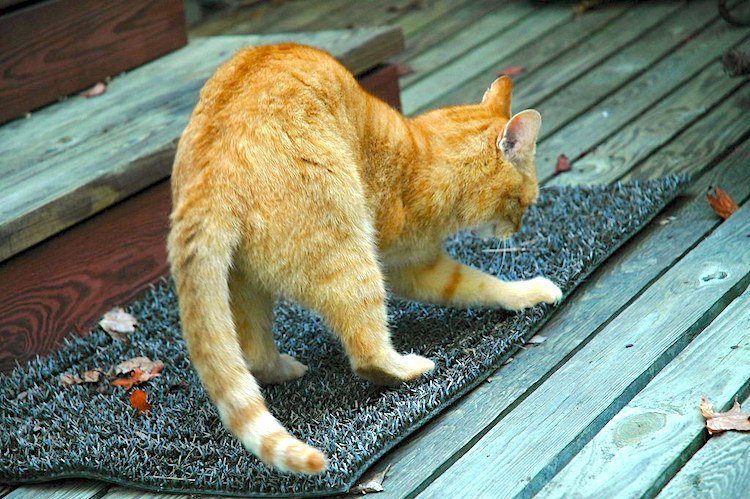
Long-term Mobility
As your pet regains confidence and begins to get around just fine, your thoughts may turn to the future. With their spare leg gone, keeping those remaining limbs strong becomes a priority.
Here are some suggestions to help reduce the risk of arthritis and keep your pet on their paws:
Joint Supplements
A daily joint supplement containing glucosamine and chondroitin is an investment in long-term joint health. These products provide the building blocks of repair for inflamed cartilage and help make joint fluid slippery.
Think of this like putting high-grade oil in a car engine. It helps keep the moving parts moving freely and stops things from seizing up.
Measured Amounts of Exercise
Three-legged pets still need exercise to keep their mind and body healthy.
The trick is not to overtire the pet. Also, try to keep to the small amount of exercise every day so their muscles build and are all the better to support their joints.
For example, the weekend warrior model is a bad idea. Dogs who rest up during the week and go for long walks on the weekend are not conditioned to heavy exercise and therefore are more likely to damage something.
Again, overtiring means the muscle get fatigued and stop supporting the joints. This puts the bones at risk of knocking together and causing the inflammation that can lead to arthritis.
Hydrotherapy is a great solution to keep pets moving. This is because the water supports the animal so their joints don’t have to take all the weight. Swimming builds muscles, which is great news, as these then support the joints.
Watch Their Weight
Carrying extra pounds puts a strain on 4 legs, let alone 3.
By watching your 3-legged pet’s waistline you’ll keep a spring in their step and help them move more freely.
The video below shows what to expect for a 3-legged kitten after amputation surgery:
Final Thoughts on Post-Amputation Care
Having to decide whether or not to put a pet through such drastic surgery can be daunting.
But with a little time, patience and understanding on your part, your dog or cat will find their feet again.
And if you have doubts, make a list and discuss it with your veterinarian, who is best placed to know your pet’s specific medical needs.
References
- “Limb Amputation.” American College of Veterinary Surgeons. https://www.acvs.org/small-animal/limb-amputation.
- Dickerson, Vanna M., DVM, et al. “Outcomes of Dogs Undergoing Limb Amputation, Owner Satisfaction With Limb Amputation Procedures, and Owner Perceptions Regarding Postsurgical Adaptation: 64 Cases (2005-2012).” Journal of the American Veterinary Medical Association 247, no. 7 (October 2015): 786–792. https://pubmed.ncbi.nlm.nih.gov/26383755/.
- Hanson, Russell R., DVM, DACVS, DACVECC. “Congenital and Inherited Disorders of Bones, Joints, and Muscles in Dogs.” Merck Veterinary Manual. https://www.merckvetmanual.com/dog-owners/bone,-joint,-and-muscle-disorders-of-dogs/congenital-and-inherited-disorders-of-bones,-joints,-and-muscles-in-dogs.
- Schubert, Thomas, DVM, DACVIM, DABVP. “Leg Paralysis in Dogs.” Merck Veterinary Manual. https://www.merckvetmanual.com/dog-owners/brain,-spinal-cord,-and-nerve-disorders-of-dogs/leg-paralysis-in-dogs.
- “K9 Hydrotherapy.” Animal Wellness Connection, LLC. https://www.animalwellnessconnection.com/K9-Hydrotherapy.html.


